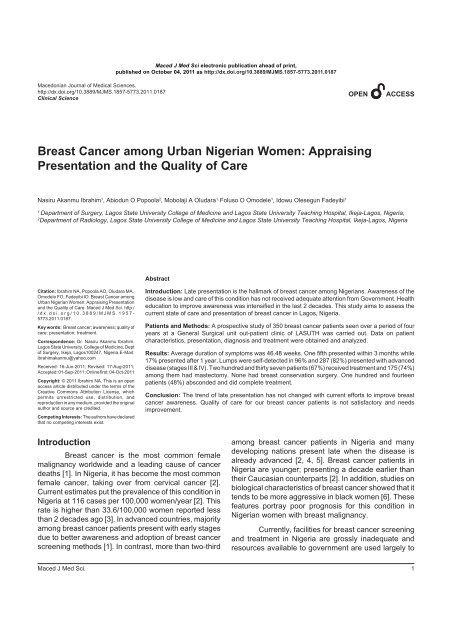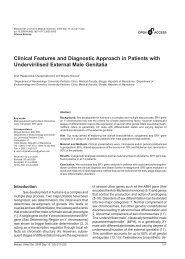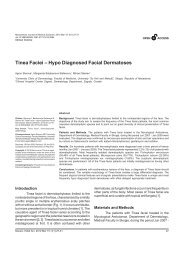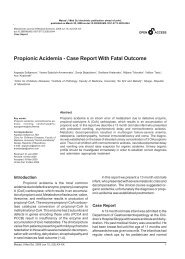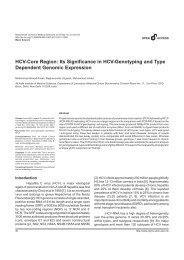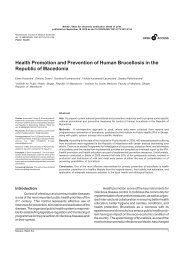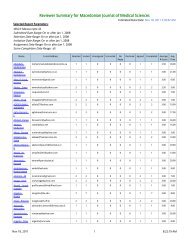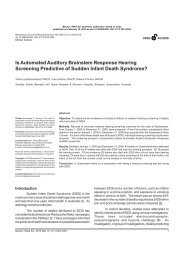Full text OnlineFirst (pdf) - Macedonian Journal of Medical Sciences
Full text OnlineFirst (pdf) - Macedonian Journal of Medical Sciences
Full text OnlineFirst (pdf) - Macedonian Journal of Medical Sciences
Create successful ePaper yourself
Turn your PDF publications into a flip-book with our unique Google optimized e-Paper software.
Maced J Med Sci electronic publication ahead <strong>of</strong> print,<br />
published on October 04, 2011 as http://dx.doi.org/10.3889/MJMS.1857-5773.2011.0187<br />
Ibrahim et al. Breast Cancer among Urban Nigerian Women<br />
<strong>Macedonian</strong> <strong>Journal</strong> <strong>of</strong> <strong>Medical</strong> <strong>Sciences</strong>.<br />
http://dx.doi.org/10.3889/MJMS.1857-5773.2011.0187<br />
Clinical Science<br />
OPENACCESS<br />
Breast Cancer among Urban Nigerian Women: Appraising<br />
Presentation and the Quality <strong>of</strong> Care<br />
Nasiru Akanmu Ibrahim 1 , Abiodun O Popoola 2 , Mobolaji A Oludara 1, Foluso O Omodele 1 , Idowu Olesegun Fadeyibi 1<br />
1<br />
Department <strong>of</strong> Surgery, Lagos State University College <strong>of</strong> Medicine and Lagos State University Teaching Hospital, Ikeja-Lagos, Nigeria;<br />
2<br />
Department <strong>of</strong> Radiology, Lagos State University College <strong>of</strong> Medicine and Lagos State University Teaching Hospital, Ikeja-Lagos, Nigeria<br />
Abstract<br />
Citation: Ibrahim NA, Popoola AO, Oludara MA, ,<br />
Omodele FO, Fadeyibi IO. Breast Cancer among<br />
Urban Nigerian Women: Appraising Presentation<br />
and the Quality <strong>of</strong> Care. Maced J Med Sci. http:/<br />
/dx.doi.org/10.3889/MJMS.1957-<br />
5773.2011.0187.<br />
Key words: Breast cancer; awareness; quality <strong>of</strong><br />
care; presentation; treatment.<br />
Correspondence: Dr. Nasiru Akanmu Ibrahim.<br />
Lagos State University, College <strong>of</strong> Medicine, Dept<br />
<strong>of</strong> Surgery, Ikeja, Lagos100247, Nigeria.E-Mail:<br />
ibrahimakanmu@yahoo.com<br />
Received: 16-Jun-2011; Revised: 17-Aug-2011;<br />
Accepted: 01-Sep-2011; Online first: 04-Oct-2011<br />
Copyright: © 2011 Ibrahim NA. This is an open<br />
access article distributed under the terms <strong>of</strong> the<br />
Creative Commons Attribution License, which<br />
permits unrestricted use, distribution, and<br />
reproduction in any medium, provided the original<br />
author and source are credited.<br />
Competing Interests: The authors have declared<br />
that no competing interests exist.<br />
Introduction: Late presentation is the hallmark <strong>of</strong> breast cancer among Nigerians. Awareness <strong>of</strong> the<br />
disease is low and care <strong>of</strong> this condition has not received adequate attention from Government. Health<br />
education to improve awareness was intensified in the last 2 decades. This study aims to assess the<br />
current state <strong>of</strong> care and presentation <strong>of</strong> breast cancer in Lagos, Nigeria.<br />
Patients and Methods: A prospective study <strong>of</strong> 350 breast cancer patients seen over a period <strong>of</strong> four<br />
years at a General Surgical unit out-patient clinic <strong>of</strong> LASUTH was carried out. Data on patient<br />
characteristics, presentation, diagnosis and treatment were obtained and analyzed.<br />
Results: Average duration <strong>of</strong> symptoms was 46.48 weeks. One fifth presented within 3 months while<br />
17% presented after 1 year. Lumps were self-detected in 96% and 287 (82%) presented with advanced<br />
disease (stages III & IV). Two hundred and thirty seven patients (67%) received treatment and 175 (74%)<br />
among them had mastectomy. None had breast conservation surgery. One hundred and fourteen<br />
patients (48%) absconded and did complete treatment.<br />
Conclusion: The trend <strong>of</strong> late presentation has not changed with current efforts to improve breast<br />
cancer awareness. Quality <strong>of</strong> care for our breast cancer patients is not satisfactory and needs<br />
improvement.<br />
Introduction<br />
Breast cancer is the most common female<br />
malignancy worldwide and a leading cause <strong>of</strong> cancer<br />
deaths [1]. In Nigeria, it has become the most common<br />
female cancer, taking over from cervical cancer [2].<br />
Current estimates put the prevalence <strong>of</strong> this condition in<br />
Nigeria at 116 cases per 100,000 women/year [2]. This<br />
rate is higher than 33.6/100,000 women reported less<br />
than 2 decades ago [3]. In advanced countries, majority<br />
among breast cancer patients present with early stages<br />
due to better awareness and adoption <strong>of</strong> breast cancer<br />
screening methods [1]. In contrast, more than two-third<br />
among breast cancer patients in Nigeria and many<br />
developing nations present late when the disease is<br />
already advanced [2, 4, 5]. Breast cancer patients in<br />
Nigeria are younger; presenting a decade earlier than<br />
their Caucasian counterparts [2]. In addition, studies on<br />
biological characteristics <strong>of</strong> breast cancer showed that it<br />
tends to be more aggressive in black women [6]. These<br />
features portray poor prognosis for this condition in<br />
Nigerian women with breast malignancy.<br />
Currently, facilities for breast cancer screening<br />
and treatment in Nigeria are grossly inadequate and<br />
resources available to government are used largely to<br />
Maced J Med Sci.<br />
1
Clinical Science<br />
tackle the challenges <strong>of</strong> communicable diseases such<br />
as HIV/AIDS, Tuberculosis, Malaria and reduction in<br />
maternal mortality. Following the establishment <strong>of</strong> Nigeria<br />
cancer society in 1968, other non–governmental<br />
organizations like the breast cancer association <strong>of</strong> Nigeria<br />
(BRECAN), the bloom Cancer and Support Centre and<br />
Princess Nikky breast cancer foundation were formed to<br />
promote breast cancer awareness and <strong>of</strong>fer support to<br />
victims <strong>of</strong> the disease in the country. In addition, regular<br />
mass screening <strong>of</strong> women in their places <strong>of</strong> work,<br />
markets and worship centres employing clinical breast<br />
examination (CBE) was commenced by Lagos State<br />
government about a decade ago.<br />
We therefore prospectively studied the<br />
characteristics, presentation and quality <strong>of</strong> care <strong>of</strong> breast<br />
cancer patients seen at the out-patient clinic <strong>of</strong> a single<br />
general surgical unit <strong>of</strong> the Lagos State University<br />
Teaching Hospital (LASUTH), Ikeja-Lagos, Nigeria<br />
between January 2006 and December 2009. The<br />
objective is to assess the current state <strong>of</strong> breast cancer<br />
care and presentation in Lagos, a highly urbanized State<br />
in Nigeria. This may assist in defining the gaps in breast<br />
cancer detection and treatment in our community. It may<br />
also help in identifying areas where improvement are<br />
needed.<br />
Methods<br />
All patients with breast cancer presenting to one<br />
<strong>of</strong> LASUTH, General Surgical Clinics between January<br />
2006 and December 2009 were prospectively studied.<br />
Informed consent was obtained and the hospital<br />
Research and Ethics committee approved the conduct<br />
<strong>of</strong> the study. Information obtained included age, sex,<br />
marital status, occupation, level <strong>of</strong> education,<br />
reproductive and social histories <strong>of</strong> the patients.<br />
Presenting complaint(s), duration <strong>of</strong> symptoms, mode <strong>of</strong><br />
lump detection, history <strong>of</strong> past breast lesions and family<br />
history <strong>of</strong> breast disease were also documented.<br />
Tumours were clinically assessed and biopsies<br />
were taken for either histological or cytological diagnosis.<br />
Assessment <strong>of</strong> metastases was done by chest X-ray<br />
and abdominal ultrasonography and where indicated,<br />
skeletal X-ray and CT scan. Staging was done using the<br />
American Joint Committee on Cancer (AJCC) method<br />
[7]. Patients whose lesions were amenable to surgery<br />
were <strong>of</strong>fered simple mastectomy and level II axillary<br />
clearance after which they were all sent to the Oncology<br />
Unit for adjuvant chemotherapy and radiotherapy. Those<br />
with advanced diseases that were not suitable for<br />
2<br />
immediate surgical intervention were referred to the<br />
Oncologist after diagnosis for neo-adjuvant<br />
chemotherapy. Radiotherapy was recommended for<br />
patients with T4 lesions, N 2<br />
or N 3<br />
nodal stage, primary<br />
tumour <strong>of</strong> 5cm or more with positive axillary lymph node,<br />
axillary lymph node <strong>of</strong> >2.5 cm in diameter and Pectoralis<br />
muscle Fascia involvement. Patients were referred to<br />
another centre for radiotherapy because the facility was<br />
not available in our hospital. They were followed up at<br />
the oncology clinic and outcomes <strong>of</strong> treatment were<br />
documented. Data was analyzed using SPSS version<br />
15.0. Frequency tables were drawn; means and<br />
proportions were also calculated.<br />
Results<br />
Characteristics <strong>of</strong> Breast Cancer Patients<br />
A total <strong>of</strong> 350 new cases <strong>of</strong> primary breast<br />
cancer were seen during the study period. Age ranged<br />
from 23 to 104 years with a mean <strong>of</strong> 48.93 years (SD ±<br />
Table 1: Characteristics <strong>of</strong> breast cancer patients in LASUTH (n<br />
= 350).<br />
_________________________________________________<br />
No %<br />
_________________________________________________<br />
Age group (years) 20 – 29 10 2.9<br />
30 – 39 86 24.6<br />
40 – 49 98 28.0<br />
50 – 59 68 19.4<br />
60 – 69 62 17.7<br />
70 – 79 22 6.3<br />
> 80 4 1.1<br />
Sex distribution Females 344 98.3<br />
Males 6 1.7<br />
Marital status Married 326 93.0<br />
Single/widowed/divorced 24 7.0<br />
Level <strong>of</strong> education Illiterate 77 22.0<br />
Primary 90 26.0<br />
Secondary 88 25.0<br />
Tertiary 95 27.0<br />
Occupation Self-employed 266 76.0<br />
Civil/public servants 56 16.0<br />
Others 28 8.0<br />
Number <strong>of</strong> children None 14 4.0<br />
1 – 4 199 57.0<br />
> 4 137 39.0<br />
Menopausal status Pre-menopausal 224 64.0<br />
Post-menopausal 126 36.0<br />
__________________________________________________<br />
http://www.mjms.ukim.edu.mk
Ibrahim et al. Breast Cancer among Urban Nigerian Women<br />
13.365). Table 1 shows socio-demographic features <strong>of</strong><br />
the patients.<br />
Clinical Presentation<br />
Three hundred and forty eight patients (99.5%)<br />
presented with breast lumps. Lumps were detected by<br />
the patients in 95% cases. In 11 patients (3%), lumps<br />
were detected by the doctor during examination for other<br />
complaints while in 4 patients (1%), they were detected<br />
by the husband. Lumps in 4 patients (1%) were discovered<br />
through clinical breast examination during government<br />
sponsored mass screening exercises. Other associated<br />
presentations include breast ulceration in 18%, breast<br />
pain in 5%, nipple retraction in 3%, bloody nipple<br />
discharge in 2% and axillary mass in 0.5%.<br />
Table 2: Distribution <strong>of</strong> symptoms duration.<br />
Duration <strong>of</strong> symptoms among patients ranged<br />
from 3 weeks to 6 ½ years. Average duration <strong>of</strong> symptoms<br />
was 46.48 weeks (SD ± 51.97). One-fifth presented<br />
within 3 months while 17% presented after 1 year (Table<br />
2). Right breast alone was affected in 157 patients (45%)<br />
and left breast alone in 144 patients (41%). In 49 patients<br />
(14%), both breasts were affected at presentation. Stage<br />
<strong>of</strong> tumour at presentation is shown in Table 3.<br />
Treatment<br />
Two hundred and thirty seven patients (67%)<br />
received treatment in our hospital while 113 patients<br />
(33%) did not report for treatment after diagnosis. Among<br />
those that were treated, 175 (74%) had simple<br />
mastectomy and axillary clearance. All <strong>of</strong> them<br />
commenced adjuvant chemotherapy after surgery. Sixty<br />
two patients (26%) whose lesions were not suitable for<br />
surgery had neo-adjuvant chemotherapy. Adriamycin<br />
and cyclophosphamide combination was used in 72% <strong>of</strong><br />
cases while 22% had cyclophosphamide, methotrexate<br />
and 5 fluorouracil (CMF) combination. All patients that<br />
received treatment were placed on oral tamoxifen<br />
empirically because our centre lacks facilities to assess<br />
hormone receptor status. One hundred and eight patients<br />
(46%) were referred for radiotherapy following completion<br />
<strong>of</strong> chemotherapy. A total <strong>of</strong> 114 patients (48%) among<br />
those that commenced therapy did not complete<br />
treatment. Forty five out <strong>of</strong> the 114 patients (39%)<br />
defaulted during the course <strong>of</strong> chemotherapy while the<br />
remaining 69 patients (61%) were not seen again at the<br />
clinic after referral for radiotherapy.<br />
Outcome<br />
Among 123 patients who did not default, 8<br />
(6.5%) died before completion <strong>of</strong> treatment and only 115<br />
(93.5) completed prescribed therapy. Another thirty<br />
patients (24%) died after completion <strong>of</strong> treatment; making<br />
a total <strong>of</strong> 38 deaths during the study period. Sixty seven<br />
patients (54.5%) are still alive and attending clinic while<br />
18 (15%) stopped attending clinic. Reasons for stopping<br />
clinic attendance could not be ascertained.<br />
Table 3: Clinical stage <strong>of</strong> tumours at presentation.<br />
Pathology<br />
Histological diagnosis was made in 296 patients<br />
(85%) while the rest (15%) had cytological diagnosis by<br />
Fine Needle Aspiration Cytology (FNAC). Invasive ductal<br />
carcinoma was the most common histological type<br />
accounting for 93% followed by invasive lobular<br />
carcinoma seen in 3%.<br />
Discussion<br />
Painless breast lump is the dominant presenting<br />
complaint in our patients and they were self-detected in<br />
nearly all cases. Substantial proportion <strong>of</strong> breast cancer<br />
is detected by mammography screening in communities<br />
with high level <strong>of</strong> awareness. In Singapore, for example,<br />
13.4% <strong>of</strong> breast cancers were screen detected [8]. In this<br />
study, only 4 patients (1%) were found to have breast<br />
cancer through mass screening employing CBE. Less<br />
than half among the patients presented within 6 months.<br />
Earlier study conducted in Lagos more than a decade<br />
ago showed that 36% reported within 6 months after<br />
observing breast cancer symptoms [9]. Late presentation<br />
is a notable feature in breast cancer patients in developing<br />
countries [4, 5]. This has been a persistent feature <strong>of</strong><br />
breast cancer presentation in Nigeria over the past 4<br />
Maced J Med Sci.<br />
3
Clinical Science<br />
decades [2, 3, 10]. Studies have shown that fear <strong>of</strong><br />
mastectomy, ignorance <strong>of</strong> the seriousness <strong>of</strong> painless<br />
breast lump, preference for traditional treatment, belief<br />
in spiritual healing and economic reasons are the main<br />
cause <strong>of</strong> late presentation <strong>of</strong> breast cancer patients in<br />
Nigeria and Ghana [11, 12]. Eighty two percent among<br />
breast cancer patients in our centre presented with<br />
advanced disease (Stages III & IV). This figure is higher<br />
than what was reported more than a decade ago when<br />
77% among breast cancer patients in Lagos presented<br />
in late stages [9]. Reports from other centres in Nigeria<br />
over the years showed that majority, ranging from 64%<br />
to 95% presented with late stages <strong>of</strong> the disease [2, 3,<br />
10, 13]. Fourteen percent had bilateral breast involvement<br />
at presentation in this study. Involvement <strong>of</strong> both breasts<br />
at presentation ranged from 1% to 9% in previous<br />
studies among breast cancer patients in Nigeria [3, 9,<br />
10, 13].<br />
Breast cancer awareness remains low among<br />
Nigerian women [14]. Patients continue to present late<br />
even when lesions are discovered early. Efforts by<br />
government and non-governmental agencies towards<br />
raising awareness and encouraging early presentation<br />
<strong>of</strong> the disease appear ineffective so far. Observed<br />
increase in the proportion <strong>of</strong> bilateral breast cancer at<br />
presentation in this study further reinforces this belief.<br />
Lagos has the largest concentration <strong>of</strong> both print and<br />
electronic media outfits used in breast cancer information<br />
dissemination in Nigeria. Furthermore, majority <strong>of</strong> the<br />
patients in the study are literate. All these do not appear<br />
to have made positive impact regarding breast cancer<br />
awareness. Communities have adopted different types<br />
<strong>of</strong> approaches towards achieving increased awareness<br />
about breast cancer. Individual–level interventions by<br />
written information, telephone counselling or interactive<br />
computer programme were tried but found to promote<br />
cancer awareness over short term only. There was no<br />
evidence that they promote early presentation with cancer<br />
symptoms [15]. However, community–level intervention<br />
through small group educational programmes, health<br />
promotion programmes in work places, health clubs and<br />
leisure centres was found to promote cancer awareness<br />
and presentation at an early stage [15]. There is need for<br />
studies aimed at identifying effective ways to achieve<br />
better awareness and early presentation <strong>of</strong> breast cancer<br />
patients in our community.<br />
Two-third among those diagnosed as having<br />
breast cancer eventually received treatment in our<br />
hospital. Simple mastectomy and level II axillary<br />
clearance were <strong>of</strong>fered to those whose lesions were still<br />
operable. None had breast conservation surgery. This is<br />
a reflection <strong>of</strong> the advanced nature <strong>of</strong> breast cancer in<br />
our patients. Few that presented with early stages were<br />
not considered for conservation surgery largely because<br />
<strong>of</strong> non-availability <strong>of</strong> radiotherapy facilities in our centre.<br />
Breast conservation surgery is currently the most popular<br />
treatment for breast cancer, representing 75 – 80% <strong>of</strong> all<br />
operations [16]. In patients presenting with large primary<br />
tumours, primary chemotherapy has been utilized to<br />
reduce the size <strong>of</strong> the tumour and make the lesion<br />
suitable for breast conservation surgery [16].<br />
Unfortunately, advanced stages at presentation and<br />
poor infrastructure for treatment <strong>of</strong> breast cancer have<br />
made this mode <strong>of</strong> surgical treatment less popular in<br />
many developing countries. None <strong>of</strong> the patients was<br />
<strong>of</strong>fered plastic surgery for breast reconstruction following<br />
mastectomy due to late presentation and the necessity<br />
for prolonged follow-up before the reconstructive<br />
procedure. Breast reconstruction after mastectomy for<br />
breast cancer has become a standard procedure. In a<br />
report, 42% among patients undergoing mastectomy<br />
had breast reconstruction with 95% being performed at<br />
the time <strong>of</strong> mastectomy [17]. Awareness about the<br />
availability <strong>of</strong> expertise and facilities for immediate breast<br />
reconstruction after mastectomy may encourage early<br />
presentation for treatment among our patients.<br />
All patients presenting for treatment had<br />
combination chemotherapy. This is an important<br />
component <strong>of</strong> breast cancer treatment and it is widely<br />
used in centres across Nigeria. One fifth among those<br />
<strong>of</strong>fered chemotherapy defaulted and did not complete<br />
the course. Non adherence to chemotherapy is a major<br />
challenge in breast cancer treatment especially in<br />
resource poor settings. Reasons for non-adherence<br />
include financial difficulty, relatively feeling well after<br />
commencement <strong>of</strong> chemotherapy, resorting to alternative<br />
treatment and drug side effects [18]. Only one-third<br />
among patients who were referred to the Radiotherapist<br />
reported to the oncology clinic after completion <strong>of</strong><br />
radiotherapy. Access to radiotherapy is a serious<br />
handicap to breast cancer treatment in developing<br />
countries. In Nigeria, a country with over 140 million<br />
inhabitants, there are only 5 functional radiotherapy<br />
centres. The high cost <strong>of</strong> this mode <strong>of</strong> treatment which is<br />
beyond what an average breast cancer patient can<br />
afford might have contributed to the non-compliance.<br />
Generally, high default rate was observed in this<br />
study. Thirty-three percent did not present for treatment<br />
after diagnosis was made while 48% among those that<br />
commenced treatment did not complete therapy. Default<br />
4<br />
http://www.mjms.ukim.edu.mk
Ibrahim et al. Breast Cancer among Urban Nigerian Women<br />
after diagnosis and during treatment for breast cancer is<br />
common among patients in Nigeria. In an earlier study in<br />
Lagos, one-third among breast cancer patients was lost<br />
to follow-up [9]. Similarly high rate <strong>of</strong> default was reported<br />
by Adesunkanmi et al in Ile-Ife, Nigeria [13]. In Accra,<br />
Ghana, one-third among breast cancer patients was lost<br />
to follow-up [19]. In addition, reasons for absconding<br />
were found to be similar to that for late presentation to the<br />
hospital [12].<br />
Conclusion and recommendation<br />
Breast cancer patients in Lagos present late<br />
with advanced stages <strong>of</strong> the disease. Awareness<br />
campaigns and health education have so far failed to<br />
change this trend in majority <strong>of</strong> patients. A new approach<br />
to breast cancer information dissemination that will<br />
address already known causes <strong>of</strong> late presentation and<br />
enhance early detection and presentation is desirable.<br />
Quality <strong>of</strong> care for our breast cancer patients needs<br />
improvement. Provision <strong>of</strong> adequate facilities for early<br />
diagnosis and treatment particularly, radiotherapy<br />
machines are necessary. High default rate after diagnosis<br />
and during treatment observed in this study is worrisome.<br />
This may be partly due to misconceptions about breast<br />
cancer treatment. It should be addressed by adopting<br />
new strategies that will encourage patients to take up<br />
and complete their treatment accordingly. Default may<br />
lessen if cost <strong>of</strong> treatment is reduced and made affordable.<br />
References<br />
1. Parkin DM, Bray F, Ferlay J, Pisani P. Global cancer statistics,<br />
2002. CA Cancer J Clin. 2005;55:74–108.<br />
2. Adebamowo CA, Ajayi OO. Breast Cancer in Nigeria. West<br />
Afr J med. 2000;19:179–191<br />
3. Ihekwaba FN. Breast cancer in Nigerian women. Br J Surg.<br />
1992;79:771-775.<br />
4. Montazeri A, Ebrahimi M, Mehrdad N, Ansari M, Sajadian<br />
A. Delayed presentation in breast cancer: A study in Iranian<br />
women. BMC Womens Health. 2003;3:4<br />
5. Hisham AN, Yip C. Overview <strong>of</strong> breast cancer in Malaysian<br />
women: A problem with late diagnosis. Asian <strong>Journal</strong> <strong>of</strong> Surgery.<br />
2004;22(2):130-133.<br />
6. Ikpat OF, Kuopio T, Ndoma-Egba R, Collan Y. Breast cancer<br />
in Nigeria and Finland: epidemiological, clinical and histological<br />
comparison. Anticancer Res. 2002;22:3005-12.<br />
7. Greene FL, Page DL, Fleming ID et al. AJCC Cancer Staging<br />
Manual. 6th edn. Springer, 2002.<br />
8. Chuwa EW, Yeo AW, Koong HN et al. Early detection <strong>of</strong><br />
breast cancer through population based mammographic<br />
screening in Asian women: a comparison study between<br />
screen-detected and symptomatic breast cancer. Breast J.<br />
2009;15(2):133-9.<br />
9. Atoyebi OA, Atimomo CE, Adesanya AA, Beredugo BK, da<br />
Rocha-Afodu JT. An appraisal <strong>of</strong> 100 patients with breast<br />
cancer seen at the Lagos University Teaching hospital, Lagos,<br />
Nigeria. Nig Quart J Hosp Med. 1997;7(2):104–108.<br />
10. Pearson JB. Carcinoma <strong>of</strong> the breast in Nigeria. A review<br />
<strong>of</strong> 100 patients. Br J Cancer. 1963;17:559–565.<br />
11. Ajekigbe AT. Fear <strong>of</strong> mastectomy: the most common factor<br />
responsible for late presentation <strong>of</strong> carcinoma <strong>of</strong> the breast in<br />
Nigeria. Clin Oncol (R Coll Radiol). 1991;3(2):78-80.<br />
12. Clegg-Lamptey J, Dakubo J, Attobra YN. Why Do Breast<br />
Cancer Patients Report Late or Abscond During Treatment in<br />
Ghana? A Pilot Study. Ghana Med J. 2009;43(3):127–131.<br />
13. Adesunkanmi ARK, Lawal OO, Adelusola KA, Durosimi<br />
MA. The Severity, Outcome and Challenges <strong>of</strong> Breast Cancer<br />
in Nigeria. The Breast. 2006;15:399-409.<br />
14. Aderounmu AO, Egbewale BE, Oj<strong>of</strong>eitimi EO et al.<br />
Knowledge, attitudes and practices <strong>of</strong> educated and noneducated<br />
women to cancer <strong>of</strong> the breast in semi-urban and<br />
rural areas <strong>of</strong> south-west, Nigeria. Niger Postgrad Med J.<br />
2006;13:182–188.<br />
15. Austoker J, Bankhead C, Forbes LJL et al. Interventions to<br />
promote cancer awareness and early presentation: systematic<br />
review. Br J Cancer. 2009;101(S2): S31–S39.<br />
16. Veronesi U, Boyle P, Goldhirsch A, Orecchia R, Viale G.<br />
Breast cancer. Lancet. 2005;365(9472):1727-41.<br />
17. Christian CK, Niland J, Edge SB et al. A multi-institutional<br />
analysis <strong>of</strong> the socio-economic determinants <strong>of</strong> breast<br />
reconstruction. Ann Surg. 2006;243(2):241-9.<br />
18. AO, Lawal OO, Adesunkanmi AR. Paradox <strong>of</strong> wellness<br />
and non-adherence among Nigerian women on breast cancer<br />
chemotherapy. J Cancer Res Ther. 2008;4(3):107-10.<br />
19. Clegg-Lamptey JNA, Hodasi WM. A study <strong>of</strong> breast cancer<br />
in Korle Bu Teaching Hospital: Assessing the impact <strong>of</strong> health<br />
education. Ghana Med J. 2007;41(2): 72–77.<br />
Maced J Med Sci.<br />
5


